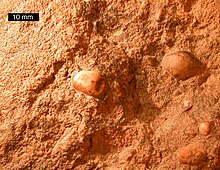Old-red sandstone

The Old-Red-Sandstone ( English : Old Red Sandstone ), also Old Red or ORS for short , is a rock formation of considerable importance for paleontology and historical geology . The names Old-Red-Facies and Old-Red-Continent are derived from these rocks, which are widespread in England and Scotland, and have a meaning that extends far beyond Great Britain in the regional geology of Europe .
He comes mainly from the Devonian .
History of exploration
The name was first used in geological literature in 1822 by William Daniel Conybeare and William Phillips .
The fossil record of the rock sequence has been extensively studied by Hugh Miller , Henry Thomas de la Bèche , Roderick Murchison, and Adam Sedgwick , and much of the stratigraphic debates of the period revolved around these rocks. Sedgwick was the one who put the Old Red sandstone in the Devonian in 1839 . In 1841, Hugh Miller's classic work, Old Red Sandstone, appeared . He described the occurrences in the north along the coast of Scotland, explained the sequence of the various distinguishable rocks and added a detailed description of the fossils contained therein , especially the abundant fish.
Sedimentology and Distribution
The Old-Red-Sandstone is a rock facies named mainly after its red sandstones and arcoses , which was deposited after the Caledonian orogeny in the late Silurian , during the Devonian and the lower Carboniferous .
The old red facies are dominated by sediments such as sandstones, arkoses, siltstones and conglomerates . It can be assigned to two deposition areas: on the one hand, the core area in England, Scotland and western Norway , which only shows deposits far from the sea, and on the other, an extensive belt of predominantly red-colored sediments in the Devonian, which stretches from southwestern England via France , Belgium and Germany as far as the eastern Baltic states .
In the core area of the Old Red, the deposits mainly accumulated in sedimentary basins , which were deposited in the area of the still young mountains after the Caledonian orogeny. The material poured into these basins mostly came from the immediate vicinity, the deposits reached thicknesses of up to 7,000 m. The sequences of the Old Red are structured by discordances , which allow the Old Red sandstone to be roughly divided into three. Signs of the deposition conditions are oblique stratification , ripples and dry cracks , which together with the low fossil record, which is concentrated in a few places, show that the older part of the Old Red was formed in rivers and lakes under a semi-arid climate. Dune deposits and wind edges associated with the formation of extensive soil crusts are indications that the younger part of the Old Red was deposited in a desert-like climate.
The usually red color is caused by iron oxide. Not all rocks of the Old-Red sandstone are colored red, however, gray claystones and conglomerates are also not uncommon. The conglomerates often form remarkable rock formations, such as the cliffs of the Fowlsheugh Nature Reserve in Kincardineshire .
In older geological publications before the theory of plate tectonics was formulated , the rocks of the so-called Catskill Delta in the Catskill Mountains of the United States were viewed as parts of the Old Red sandstone. Today it is known that the two are not stratigraphically related, but are only about the same age and, due to similar deposit conditions, are very similar.
Old-red sandstone as a building material

In areas where the rocks of the Old Red Sandstone near or at the surface receptive are the material as a building material was used for many stone houses. Notable examples can be found in the Stirling , Stonehaven , Perth and Tayside areas . The residents of Caithness, on the northeast tip of Scotland, also made extensive use of the block.
Well-known buildings made of old-red sandstone
- Cawdor Castle , Scotland
- Muchalls Castle , Scotland
- Stonehaven Tolbooth , Scotland
- Sweetheart Abbey , Scotland
- Tintern Abbey , South Wales
- Ross-on-Wye , Market Hall, Herefordshire
- Shrewsbury Castle , Shropshire
See also
literature
- Hugh Miller: The old red sandstone: or, New walks in an old field . J. Johnstone, Edinburgh 1841.
Individual evidence
- ^ Hans Murawski, Wilhelm Meyer: Geological dictionary . 11th edition. Elsevier / Spektrum, Heidelberg 2004, ISBN 3-8274-1445-8 .
- ^ Stratigraphical framework for the Devonian (Old Red Sandstone) rocks of Scotland south of a line from Fort William to Aberdeen. British Geological Survey Research Report RR / 01/04, p. 1 (pdf)
- ^ A b Karl Krömmelbein: Brinkmanns Abriß der Geologie. second volume: historical geology. 10/11 Edition, Ferdinand Enke Verlag, Stuttgart 1977, ISBN 3-432-80600-0 .
- ^ Photo of the Wallace Monument, Stirling
- ^ Photo of Allardice Street, Stonehaven
- ^ Photo of the Lower City Mills, Perth
- ^ Photo of the Bothy, Keiss Harbor, Caithness

